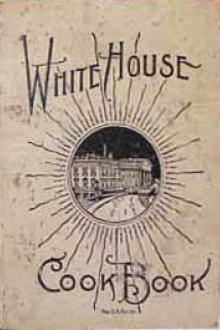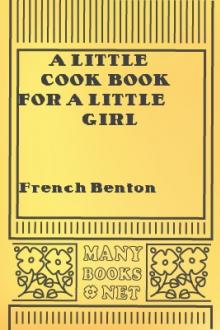The Whitehouse Cookbook (1887), Hugo Ziemann [world of reading .TXT] 📗

- Author: Hugo Ziemann
- Performer: -
Book online «The Whitehouse Cookbook (1887), Hugo Ziemann [world of reading .TXT] 📗». Author Hugo Ziemann
Or, you may get two dozen freshly opened very small clams. Boil a pint of milk, a dash of white pepper and a small pat of butter. Now add the clams. Let them come to a boil and serve. Longer boiling will make the clams almost indigestible.
ROAST CLAMS IN THE SHELL.
Roast in a pan over a hot fire, or in a hot oven, or, at a "Clam Bake," on hot stones; when they open, empty the juice into a saucepan; add the clams, with butter, pepper and a very little salt.
CLAM FRITTERS.
Take fifty small or twenty-five large sand clams from their shells; if large, cut each in two, lay them on a thickly-folded napkin; put a pint bowl of wheat flour into a basin, add to it three well-beaten eggs, half a pint of sweet milk and nearly as much of their own liquor; beat the batter until it is smooth and perfectly free from lumps, then stir in the clams. Put plenty of lard or beef fat into a thick-bottomed frying pan, let it become boiling hot; put in the batter by the spoonful; let them fry gently; when one side is a delicate brown turn the other.
CLAM CHOWDER.
The materials needed are fifty round clams (quahogs), a large bowl of salt pork cut up fine, the same of onions finely chopped, and the same (or more, if you desire) of potatoes cut into eighths or sixteenths of original size; wash the clams very thoroughly and put them in a pot with half a pint of water; when the shells are open they are done; then take them from the shells and chop fine, saving all the clam water for the chowder; fry out the pork very gently, and when the scraps are a good brown take them out and put in the chopped onions to fry; they should be fried in a frying pan, and the chowder kettle be made very clean before they are put in it, or the chowder will burn. (The chief secret in chowder-making is to fry the onions so delicately that they will be missing in the chowder.)
Add a quart of hot water to the onions; put in the clams, clam-water and pork scraps. After it boils, add the potatoes, and when they are cooked, the chowder is finished. Just before it is taken up, thicken it with a cup of powdered crackers, and add a quart of fresh milk. If too rich, add more water. No seasoning is needed but good black pepper.
With the addition of six sliced tomatoes, or half a can of the canned ones, this is the best recipe of this kind, and is served in many of our best restaurants.
SCALLOPED CLAMS.
Purchase a dozen large soft clams in the shell and three dozen opened clams. Ask the dealer to open the first dozen, care being used not to injure the shells, which are to be used in cooking the clams. Clean the shells well, and put two soft clams on each half shell; add to each a dash of white pepper, and half a teaspoonful of minced celery. Cut a slice of fat bacon into the smallest dice, add four of these to each shell, strew over the top a thin layer of cracker dust; place a piece of table butter on top, and bake in the oven until brown. They are delightful when properly prepared.
SCALLOPS.
If bought in the shell boil them and take out the hearts, which is the only part used. Dip them in beaten egg and fry in the same manner as oysters.
Some prefer them stewed the same as oysters.
FROGS FRIED.
Frog are usually fried, and are considered a great delicacy. Only the hind-legs and quarters are used. Clean them well, season, and fry in egg batter, or dip in beaten egg and fine cracker crumbs, the same as oysters.
FROGS STEWED.
Wash and skin the quarters, parboil them about three minutes, drain them. Now put into a stewpan two ounces of butter. When it is melted, lay in the frogs, and fry about two minutes, stirring them to prevent burning; shake over them a tablespoonful of sifted flour and stir it into them; add a sprig of parsley, a pinch of powdered summer savory, a bay leaf, three slices of onion, salt and pepper, a cup of hot water and one of cream. Boil gently until done; remove the legs, strain and mix into the gravy the yolks of two eggs, well beaten to a cream; put the legs in a suitable dish, pour over the gravy and serve.
In choosing poultry, select those that are fresh and fat, and the surest way to determine whether they are young is to try the skin under the leg or wing. If it is easily broken, it is young; or, turn the wing backwards, if the joint yields readily, it is tender. When poultry is young the skin is thin and tender, the legs smooth, the feet moist and limber, and the eyes full and bright. The body should be thick and the breast fat. Old turkeys have long hairs, and the flesh is purplish where it shows under the skin on the legs and back. About March they deteriorate in quality.
Young ducks and geese are plump, with light, semi-transparent fat, soft breast bone, tender flesh, leg-joints which will break by the weight of the bird, fresh-colored and brittle beaks, and windpipes that break when pressed between the thumb and forefinger. They are best in fall and winter.
Young pigeons have light red flesh upon the breast, and full, fresh-colored legs; when the legs are thin and the breast very dark the birds are old.
Fine game birds are always heavy for their size; the flesh of the breast is firm and plump and the skin clear; and if a few feathers be plucked from the inside of the leg and around the vent, the flesh of freshly-killed birds will be fat and fresh-colored; if it is dark and discolored, the game has been hung a long time. The wings of good ducks, geese, pheasants and woodcock are tender to the touch; the tips of the long wing feathers of partridges are pointed in young birds and round in old ones. Quail, snipe and small birds should have full, tender breasts. Poultry should never be cooked until six or eight hours after it has been killed, but it should be picked and drawn as soon as possible. Plunge it in a pot of scalding hot water; then pluck off the feathers, taking care not to tear the skin; when it is picked clean, roll up a piece of white paper, set fire to it and singe off all the hairs. The head, neck and feet should be cut off, and the ends of the legs skewered to the body, and a string tied tightly around the body. When roasting a chicken or small fowl there is danger of the legs browning or becoming too hard to be eaten. To avoid this, take strips of cloth, dip them into a little melted lard, or even just rub them over with lard, and wind them around the legs. Remove them in time to allow the legs to brown delicately.
Fowls, and also various kinds of game, when bought at our city markets, require a more thorough cleansing than those sold in country places, where as a general thing the meat is wholly dressed. In large cities they lay for some length of time with the intestines undrawn, until the flavor of them diffuses itself all through the meat, rendering it distasteful. In this case, it is safe, after taking out the intestines, to rinse out in several waters, and in next to the last water, add a teaspoonful of baking soda, say to a quart of water. This process neutralizes all sourness, and helps to destroy all unpleasant taste in the meat.
Poultry may be baked so that its wings and legs are soft and tender, by being placed in a deep roasting pan with close cover, thereby retaining the aroma and essences by absorption while confined. These pans are a recent innovation, and are made double with a small opening in the top for giving vent to the accumulation of steam and gases when required. Roast meats of any kind can also be cooked in the same manner, and it is a great improvement on the old plan.
ROAST TURKEY.
Select a young turkey; remove all the feathers carefully, singe it over a burning newspaper on the top of the stove; then "draw" it nicely, being very careful not to break any of the internal organs; remove the crop carefully; cut off the head, and tie the neck close to the body by drawing the skin over it. Now rinse the inside of the turkey out with several waters, and in the next to the last, mix a teaspoonful of baking soda; oftentimes the inside of a fowl is very sour, especially if it is not freshly killed. Soda, being cleansing, acts as a corrective, and destroys that unpleasant taste which we frequently experience in the dressing when fowls have been killed for some time. Now, after washing, wipe the turkey dry, inside and out, with a clean cloth, rub the inside with some salt, then stuff the breast and body with "Dressing for Fowls." Then sew up the turkey with a strong thread, tie the legs and wings to the body, rub it over with a little soft butter, sprinkle over some salt and pepper, dredge with a little flour; place it in a dripping-pan, pour in a cup of boiling water, and set in the oven. Baste the turkey often, turning it around occasionally so that every part will be uniformly baked. When pierced with a fork and the liquid runs out perfectly clear, the bird is done. If any part is likely to scorch, pin over it a piece of buttered white paper. A fifteen pound turkey requires between three and four hours to bake. Serve with cranberry sauce.
Gravy for Turkey.—When you put the turkey in to roast, put the neck, heart, liver and gizzard into a stewpan with a pint of water; boil until they become quite tender; take them out of the water, chop the heart and gizzard, mash the liver and throw away the neck; return the chopped heart, gizzard and liver to the liquor in which they were stewed; set it to one side, and when the turkey is done it should be added to the gravy that dripped from the turkey, having first skimmed off the fat from the surface of the dripping-pan; set it all over the fire, boil three minutes and thicken with flour. It will not need brown flour to color the gravy. The garnishes for turkey or chicken are fried oysters, thin slices of ham, slices of lemon, fried sausages, or force meat balls, also parsley.
DRESSING OR STUFFING FOR FOWLS.
For an eight or ten pound turkey, cut the brown crust from slices or pieces of stale bread until you have as much as the inside of a pound loaf; put it into a suitable dish and pour tepid water (not warm, for that makes it heavy) over it; let it stand one minute, as it soaks very quickly. Now take up a handful at a time and squeeze it hard and dry with both hands, placing it, as you go along, in another dish; this process makes it very light. When





Comments (0)